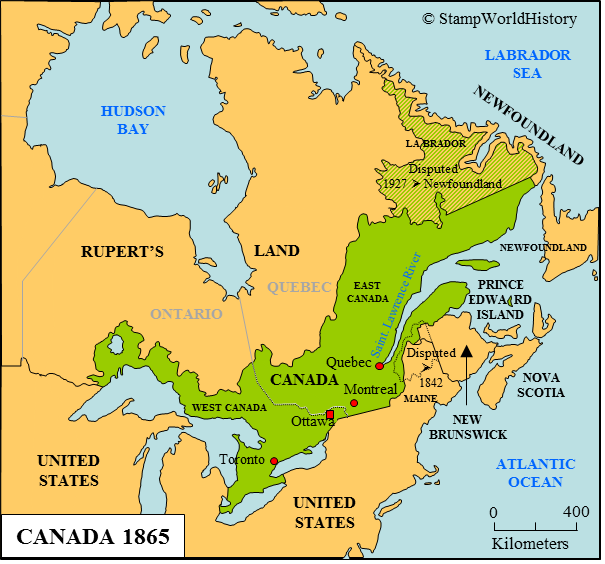Tags
Act of Union 1840, Confederation, Constitutional Act 1791, Maps of Canada, Present Day, Quebec Act 1774, Today, Tom Thomson

1. The Quebec Act, 1774
New France fell to Britain in 1759 (Quebec City), 1760 (Montreal), and by virtue of the Treaty of Paris, 1763. The Quebec Act (1774) gave French-speaking Canadians a status that approximated the status of English-speaking Canadians. The Governor of Canada was Guy Carleton, 1st Baron Dorchester.

2. The Constitutional Act, 1791
After the American Revolutionary War, the United Empire Loyalists moved to Canada. The Constitutional Act of 1791 divided the large province of Quebec into Upper Canada and Lower Canada. Most of the inhabitants of Upper Canada spoke English. In Lower Canada, the majority of Canadians were French-speaking (Canadiens). English-speaking newcomers also settled in Lower Canada. The Eastern Townships would be home to a large number of English-speaking Canadians. But many French-speaking Canadians felt Lower Canada was their land.
Both the citizens of Upper Canada and Lower Canada rebelled in 1837-1838. The Crown levied money from its British North American colonies.

3. The Act of Union, 1840
Lord Durham investigated the Rebellions of 1837-1838. He recommended the union of the two Canadas. He hoped English-speaking Canadians would outnumber French-speaking Canadians.

4. Confederation Onwards
The Purchase of Rupert’s Land from the Hudson’s Bay Company transformed Canada into a large territory.

5. Canada, as it is

Love to everyone 💕
© Micheline Walker
15 October 2020
WordPress


It seems unfair that Ontario is the only province to border the Great Lakes.
LikeLike
Such things are not always fair. The Great Lakes are an extraordinary resource. A seaway now allows large ships to travel from the Saint Lawrence River to Toronto. It improved Ontario’s economy. Other posts now have links to these maps. 🙂
LikeLiked by 1 person
Lovely maps. I want to thank you for following my posts. I thoroughly enjoy your beautiful, informative ones.
LikeLike
Thank you very much. Those maps are revealing. I enjoy gaining knowledge and sharing it. Your posts are excellent and informative. Stay well, Micheline
LikeLike
A fascinating historical journey
LikeLike
Dear Derrick. The maps do it. This is what happened between the Fall of New France until Confederation. The good news is that English-speaking and French-speaking Canadians get along very well. Louis-Hippolyte LaFontaine was Canada’s first Prime Minister, but Robert Baldwin, who wasn’t well after his wife died, helped masterminded a bilingual and bicultural Canada. This was before Confederation. After Confederation, the first Prime Minister is John A. Macdonald. He made mistakes associated with colonialism. So, should we or should we not remove statues of the gentleman? Assimilating the French is also part of colonialism, but the Rebellions had little to do with ethnicity. It was the beginning of a quest for a responsible government. Major de Salaberry respected his French-speaking Voltigeurs. Fifty or some years after the Conquest, by Britain, they fought alongside the British. They liked the British system, a Queen/King and Parliament. 🙂
LikeLike
v informative
LikeLike
Thank you for writing. These maps help reveal history as it was.
LikeLike